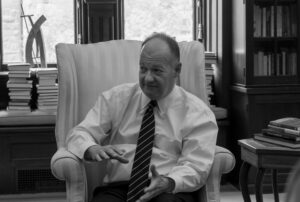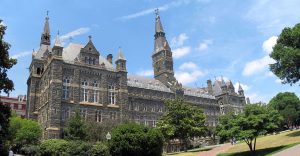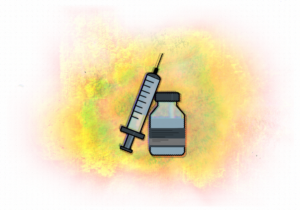On March 21, Georgetown implemented a mask-optional policy in university-operated buildings, including residential halls, classrooms, and dining facilities. Masks must still be worn in healthcare facilities, in areas designated for COVID testing, on the GUTS bus per federal law, and during the 10 days after exposure or infection to COVID. This decision was first communicated to the student body in a March 11 email by Provost Robert M. Groves.
The same week, Georgetown reported 96 positive COVID-19 cases, double the positive test rate from the previous week.
Responses from the student body to the lifting of the mask mandate have been mixed: many students have chosen to remain masked indoors, especially in large lecture halls but others have opted not to wear masks.
Regardless of their personal choices in masking, students have expressed surprise about the university’s announcement.
“I was shocked at the beginning, especially that they lifted it for every class. I would understand that for a 10-person class, but for classes like economics with like a hundred people in a lecture hall, it’s pretty shocking to not have a mask mandate,” Sofia Ernst (MSB ’25) said.
“It’s a pretty big step for Georgetown, but overall, I know that many people on campus are very relieved by hearing the news,” she added.
Clara Hoffmann (COL ’25) likewise expressed surprise about the lifting of the mask mandate but viewed it as a positive change.
“It was quite exciting, a little bit shocking as well because this pandemic has been going on for so long,” Hoffmann said. “Personally, I felt I would be comfortable not wearing a mask because Georgetown does do testing.”
The lifting of the mask mandate comes after new D.C. health guidelines on March 8 permitted educational facilities to roll back mask mandates should infection rates remain low. The university cited both low positivity rates and a low number of cases within the Georgetown community, as well as in the city at large, as reasons for repealing the mask mandate.
Daily cases hover around 70 per day in D.C.—well below the 100 case per day threshold that senior D.C. health official Patrick Ashley defined as reasonable enough to not influence individual behavior.
For Casey Goss (NHS ’25), while the mask-optional policy has made her feel slightly less safe than before, it’s also changed her perception of masking, which she now views as more of a choice than she did before.
“Earlier what was bothering me when people weren’t wearing a mask was more that they weren’t following the rules and not that they weren’t wearing a mask,” Goss said. “Now that there’s no rule saying that they have to wear a mask, it’s more that someone is choosing to not wear a mask—they’re still listening, they’re still following the rule, they’re just making a different choice than me.”
Nevertheless, many students and faculty have raised concerns about the mask-optional policy and some faculty members have surveyed their students on the new masking guidelines. Of the 84 students who responded to a survey in Professor Manus Patten’s “Foundations in Biology II” course, 38 reported a comfortability of either a four or five out of five with being unmasked in the lecture hall. That number rose to 49 out of the 84 students comfortable going unmasked in smaller lab groups, with many citing the smaller class sizes in labs. Students who chose to wear masks pointed out challenges in social distancing during lectures and labs, as well as the onset of the BA.2 variant, as a salient concern for unmasking in either space.
BA.2, a more contagious variant of Omicron, is spreading rapidly across Europe as of March 26, and now accounts for around 30 percent of all cases in the Mid-Atlantic region. It’s believed that people who have contracted the original Omicron variant may have some existing immunity against BA.2, but individuals who contracted variants before Omicron can experience reinfections. Public health experts believe that vaccination remains an effective means of protection against the new variant, though they warn that it will likely become the dominant strain in D.C. over the next few weeks.
Dr. Shweta Bansal, associate professor of biology and expert in disease ecology, created and shared a slideshow detailing the risks of Georgetown’s new masking policy with several classes, including both her own students and other professors’. Bansal noted that while the policy is consistent with CDC guidelines, unique considerations have always been salient for the Georgetown community.
“Campus communities are unique settings with intense indoor contact (which is very high risk for SARS-CoV2 transmission) and we have repeatedly over the last two years opted for more conservative policy than CDC guidelines to protect our community,” Bansal wrote. “Our positivity rates have declined significantly [since the beginning of spring semester], but we’re still above 1 percent, which is way higher than at any time during the fall semester.”
Bansal wrote that the new masking policy has shifted the burden of protection onto vulnerable populations, including immunocompromised individuals who are insufficiently protected by vaccines. She also cited data showing that Black, Hispanic, and American Indian or Alaska Native populations experience hospitalization and death at rates up to twice as high as their white counterparts.
Bansal also cautioned against community members who do not identify in the previous categories exempting themselves from the risks of contracting COVID, including potential long-term neurological impacts that are currently being researched.
“In all our othering of ‘vulnerable’ people, we are not realizing how little we know about this virus and what it does to the human body,” Bansal wrote. “[We] finally have enough data to start looking at the long-term consequences of this virus, and we’re finding that a quarter of vaccinated people are still experiencing symptoms months later (things like fatigue, general anxiety, difficulty breathing), even in previously healthy individuals.”
Some students are keenly aware of the distinct risks to certain populations on campus.
“As a TA for a class studying disability studies, we are more likely to have individuals who are more vulnerable at times to COVID, and same with some of our professors. It seemed like dialogue [between the university and faculty] at times was missing,” Emily Fisher (SFS ’22), a teaching assistant for a course on disability justice at the Center for Jewish Civilizations (CJC), said. “It stood out to me given the timeframe that it seemed to me like professors and staff members were not consulted.”
Fisher noted that the CJC course has included a Zoom option for students hesitant to return to class due to the change in mask mandates, and some CJC professors have chosen to remain virtual. In regards to her own comfortability with the new masking guidelines, Fisher expressed concern.
“I don’t necessarily trust that students will test regularly,” Fisher said. “I hope that students demonstrate empathy about the professors’ situations if they prefer that their students be masked. I [also] hope that students are aware that their actions impact others who they may never know.”




